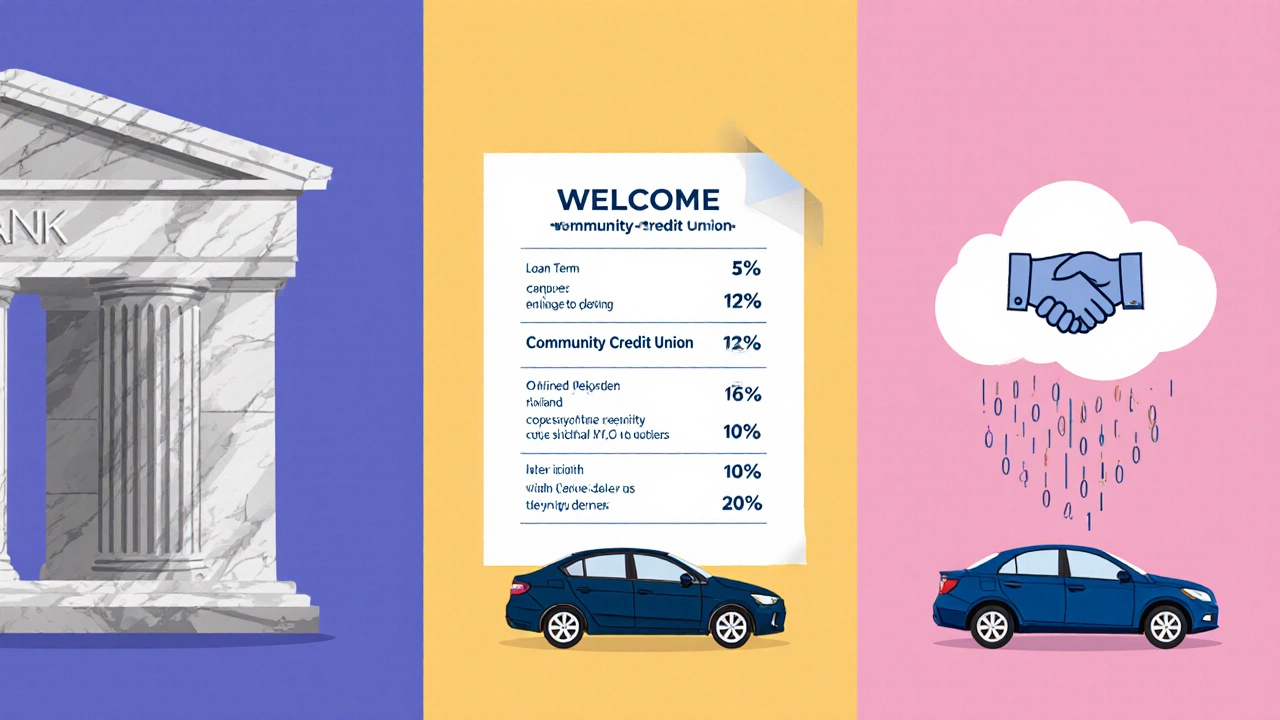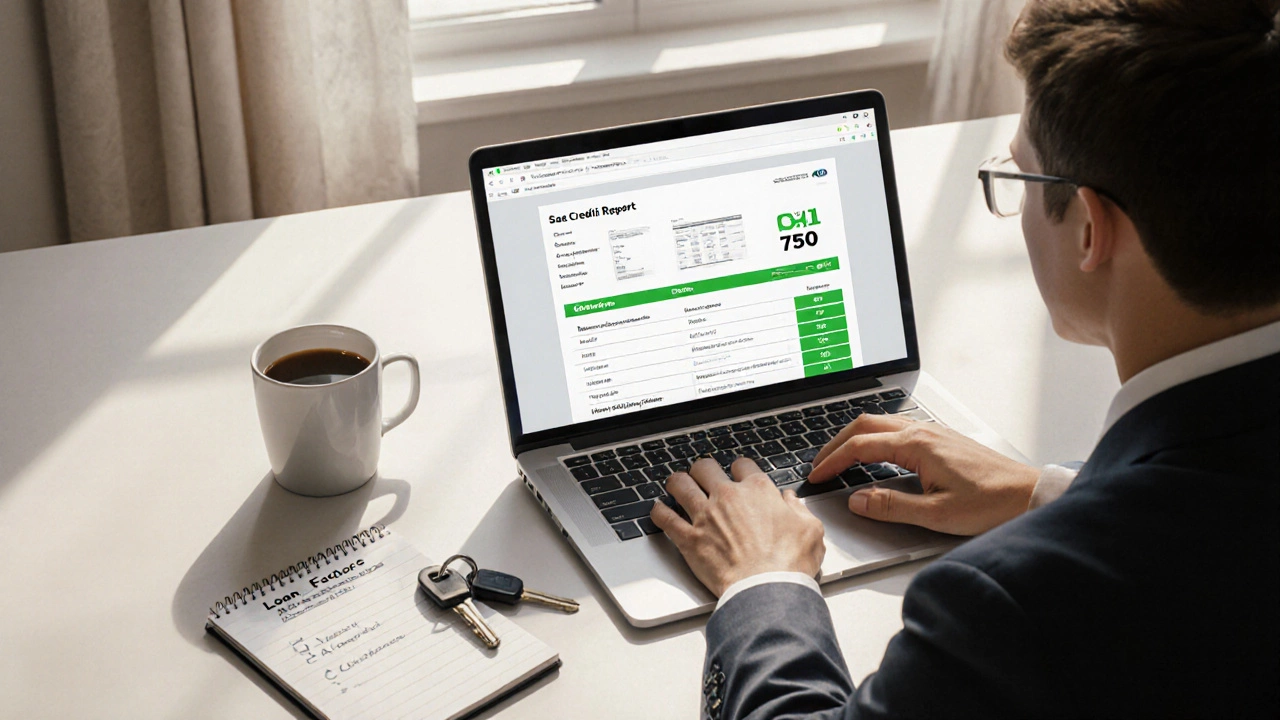Car Loan APR Calculator for 750 Credit Score
Your Loan Summary
Financed Amount: €21,250
Loan Term: 60 months
Down Payment: €3,750 (15%)
Estimated APR: 3.3%
Monthly Payment: €386
Total Interest Paid: €1,860
Key Takeaways
- A 750 credit score usually lands you an APR between 3% and 5% on a new‑car loan.
- Loan term, down payment, and lender type can shift that rate up or down by a full percentage point.
- Shop around at banks, credit unions, and online lenders - the best deal often isn’t the first quote you receive.
- Keep your debt‑to‑income (DTI) ratio below 36% and your credit utilization under 30% to maximise the rate offered.
- Use a simple calculator to see how a 0.5% change in APR affects your monthly payment.
Got a 750 credit score and wondering what kind of car loan rate you can actually snag? You’re not alone. Most buyers think a “good” score guarantees a low rate, but the truth is a little messier. Lenders look at a handful of numbers - your credit score, the loan term you pick, how much you put down, and even the type of lender you choose. This guide breaks down each piece, shows you realistic APR ranges, and hands you a step‑by‑step plan to lock in the best possible deal.
First, let’s define the core concepts you’ll see on any loan offer.
Car loan interest rate is the percentage charged on the amount you borrow to buy a vehicle. It’s expressed as an annual percentage rate (APR) and determines how much extra you’ll pay over the life of the loan.
Credit score is a three‑digit number that reflects your creditworthiness, with 750 falling solidly in the “good” range (700‑749). Most lenders use a FICO model, where higher scores earn lower APRs.
APR (annual percentage rate) includes both the interest rate and any lender fees, giving you a true cost of borrowing.
Lender can be a bank, credit union, online finance company, or the dealership’s in‑house financing arm. Each has its own risk assessment and pricing model.
Loan term is the length of time you agree to repay the loan, typically 36, 48, 60, or 72 months for auto loans.
Down payment is the cash you put toward the vehicle price up front. A larger down payment reduces the financed amount and often improves the APR you’re offered.
Debt‑to‑income ratio (DTI) measures how much of your monthly income goes toward debt payments. Lenders prefer a DTI under 36%.
Vehicle price is the sticker price of the car plus any add‑ons, less trade‑in value. It sets the ceiling for how much you can finance.
How a 750 Score Translates into Real‑World APRs
When you walk into a dealership or hit an online quote tool with a 750 score, most lenders will slot you into the “good‑to‑excellent” bucket. In the United States (and similarly in Ireland for European‑based lenders), that bucket typically yields APRs ranging from 3.0% to 5.0% for new‑car purchases.
Why the spread? Two main reasons:
- Risk assessment nuances: Even within the 750‑779 range, a lender’s internal model may assign a slightly higher risk if your recent credit inquiries or account balances look heavy.
- Deal specifics: The loan term you choose, the size of your down payment, and the age of the vehicle all adjust the final APR.
In practice, you’ll see offers like:
- Bank A: 3.2% APR for a 36‑month loan with a 20% down payment.
- Credit Union B: 3.5% APR for a 60‑month loan with a 10% down payment.
- Online Lender C: 4.8% APR for a 72‑month loan with a 5% down payment.
Notice how the longer term and smaller down payment push the rate higher. That’s the lever you can control.
Key Drivers That Can Nudge Your Rate Up or Down
Besides the obvious credit score, four variables have the biggest impact on the final APR.
1. Loan Term Length
Shorter terms mean less time for the lender’s money to sit at risk, so they reward you with lower rates. A 36‑month loan can be 0.5%-1% cheaper than a 72‑month loan, all else equal.
2. Down Payment Size
Putting more cash down lowers the loan‑to‑value (LTV) ratio. An LTV under 80% often qualifies for the “prime” rate, while anything above can add a point or two.
3. Lender Type
Credit unions usually offer the best rates for good scores because they’re non‑profit and prioritize member savings. Banks sit in the middle, and dealership financing can be the most expensive, especially if you opt for “zero‑percent” promos that hide hidden fees.
4. Debt‑to‑Income Ratio
If your monthly debt payments already chew up a large chunk of your income, lenders see you as a higher risk and may bump the APR. Aim to keep DTI under 36% before applying.

Typical APR Ranges by Credit Score (2025 Data)
| Credit Score | Typical APR (36‑month) | Typical APR (60‑month) | Typical APR (72‑month) |
|---|---|---|---|
| 720‑749 | 3.2% - 3.8% | 3.5% - 4.2% | 4.0% - 4.8% |
| 750‑779 | 3.0% - 3.5% | 3.3% - 4.0% | 3.8% - 4.5% |
| 780‑799 | 2.8% - 3.2% | 3.1% - 3.7% | 3.6% - 4.2% |
| 800+ | 2.5% - 2.9% | 2.9% - 3.4% | 3.4% - 3.9% |
Since you sit in the 750‑779 band, expect around 3.0%-3.5% if you choose a 36‑month term and put down at least 20%.
Step‑by‑Step: How to Secure the Best Rate
- Check your full credit report. Verify that the score you see matches the report from the major bureaus. Dispute any errors - a single mistaken late payment can shave 0.25%-0.5% off your APR.
- Calculate your DTI. Add up all monthly debt payments (including the projected car payment) and divide by gross monthly income. If it’s above 36%, consider paying down a credit card or postponing the purchase.
- Save for a larger down payment. Even an extra 5% can drop your LTV from 90% to 85%, which often qualifies you for the lender’s “prime” rate tier.
- Shop three‑plus lenders. Get pre‑approval quotes from a bank, a credit union, and an online lender. Compare the APR, any origination fees, and the total cost over the loan term.
- Negotiate the APR. Once you have multiple offers, ask each lender to beat the lowest quote. Many will shave a tenth of a point just to win your business.
- Lock the rate. If you find a great rate, ask the lender to lock it for 30-60 days. This protects you from market shifts before you finalize the paperwork.
- Read the fine print. Look for hidden fees like documentation charges, pre‑payment penalties, or early‑termination charges. Those can bump the effective APR.
Quick Calculator Example
Let’s say you want a €25,000 new car, you have a 750 credit score, and you can put down 15% (€3,750). The financed amount is €21,250.
Using a 3.3% APR for a 60‑month term:
- Monthly payment ≈ €386.
- Total interest paid over 5 years ≈ €1,860.
If the APR jumps to 4.3% because you stretch the term to 72 months, the payment drops to €339, but you end up paying €2,860 in interest - a full €1,000 more. That illustrates why a lower rate often outweighs a longer, cheaper‑looking payment.

Common Pitfalls and How to Avoid Them
- Chasing “zero‑percent” dealer financing. Those deals usually require a very high credit score and a short loan term. If you don’t qualify, you may be pushed into a higher‑rate loan with hidden fees.
- Skipping the pre‑approval step. Walking into a dealership without a pre‑approved quote gives the dealer a stronger negotiating position.
- Ignoring the total cost. Focusing only on the monthly payment can hide the fact that a longer term dramatically raises the overall interest paid.
- Over‑extending your budget. Even if the lender approves a high‑priced vehicle, you’ll still have to manage the payment along with other debts.
Next Steps: Put the Plan into Action
Pick up your credit report today, run the simple DTI check, and decide on a comfortable down payment. Then fire off three quick‑quote requests - one to your bank, one to a local credit union, and one to a reputable online lender. When the numbers land, use the calculator example above to see the real cost. Finally, lock in the best APR you can negotiate and sign the contract.
Frequently Asked Questions
What APR can I realistically expect with a 750 credit score?
For a new‑car loan, most lenders offer APRs between 3.0% and 3.5% on a 36‑month term when you have a 750 score and put down at least 20%.
Does the type of lender matter?
Yes. Credit unions typically give the lowest rates for good scores, followed by banks, then dealership financing, which is usually the most expensive.
How much does a larger down payment affect my rate?
Every 5% increase in down payment can shave about 0.2%-0.4% off the APR by lowering the loan‑to‑value ratio.
Should I choose a shorter loan term?
Shorter terms usually carry lower rates and reduce total interest, but the monthly payment will be higher. Balance what you can afford each month against how much you want to save overall.
Can I lock in an APR before I find the exact car?
Most lenders will lock a rate for 30‑60 days once you’re pre‑approved, even if you haven’t picked the exact vehicle. Just confirm the lock period in writing.
